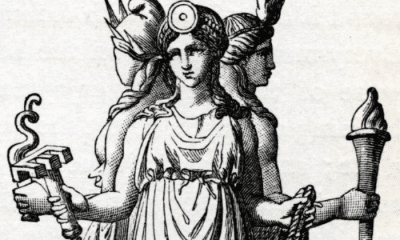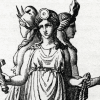Greek
Who Defeated the Minotaur?
The Minotaur is one of the most iconic monsters of Greek mythology, but how much do you remember about the hero who defeated it?
The Minotaur was a monstrous man with the head of a bull who was imprisoned in the famous Labyrinth of Crete. To keep the man-eating beast fed, King Minos demanded young men and women be sacrificed from the conquered city of Athens.
The king of Athens himself could not end the barbaric practice, but his son vowed to kill the monster and protect the youths of the city. Theseus, however, had his own complicated relationship with the city of Athens.
The young prince had not been born in Athens and had only recently arrived in his father’s city. Already making a name for himself as a monster slayer, Theseus had travelled from Troezen to take his place as heir.
The young hero was not just the child of King Aegeus, but was also considered a son of Poseidon. The dual parentage of Theseus shows both the mythological and historic meaning behind the legend of the Minotaur.
Theseus in the Minotaur’s Labyrinth
The Minotaur, the legendary bull-headed monster of Crete, had been imprisoned in the Labyrinth by King Minos. Needing to feed the cannibalistic beast, the king demanded the sacrifices of young men and women of Athens.
It was one of these young men who would defeat the Minotaur, but he was not an ordinary sacrificial victim.
Theseus was the son of the Athenian king, Aegeus, but he had not been raised in that city. Instead, he had grown up unaware of his ancestry in his mother’s home city of Troezen.
Athenian legend said that King Aegeus had no children and was anxious over who would inherit his kingdom upon his death. He sought the advice of an oracle but, as was often the case, the prophecy was given as a riddle he could not understand at the time.
Discouraged, he began to make his way home. On the journey, he stopped in the city of Troezen and was hosted by its king.
The king of Troezen believed that he understood what the oracle had meant when she advised Aegeus not to loosen the head of his wineskin too soon. Furthermore, he believed it involved his own daughter, Aethra.
The king was certain that Aethra would bare the Athenian king a son, even though none of his previous wives had. He gave Aegeus strong wine and sent Aethra to his chambers that night.
Aethra herself had another vision, however. Athena told her that she needed to go to the beach at night and wade into the water.
The princess did so, and was visited by Poseidon.
Thus, she conceived a child that was the son of both the mortal king of Athens and the god of the sea. Aegeus did not stay in Troezen for the birth of his son, but left his sword and shield for the boy to find when he was older.
Theseus grew up unaware of his parentage until he discovered these gifts. Knowing this meant he was old enough to make the journey, Aethra told him the story of his birth and urged him to go to Athens.
Although a journey by sea would have been easier, Theseus chose the more difficult land route to reach Athens. Along the way, he made a name for himself as a burgeoning hero by slaying seven monsters who guarded doorways to the Underworld.
When he reached Athens only his father’s latest wife, the witch Medea, saw the resemblance between Theseus and Aegeus. The king did not recognize his grown son, however, so the jealous witch-queen sent him on many dangerous quests.
After Theseus killed the Cretan Bull, the Minotaur’s father, Aegeus finally saw the sword and shield he had left in Troezen. He welcomed his son as the heir to his throne and sent Medea into exile for her betrayal.
While Aegeus welcomed his only son happily, Theseus saw that all was not well in Athens. The city had been conquered by the Cretans and another group of young sacrifices was due to be sent to the island shortly after his arrival.
Theseus asked to take the place of one of the young men who had been selected for the trip. Aegeus was reluctant to risk losing his only son so soon after his arrival, but relented when Theseus assured him that he could prevail.
Theseus traveled to Crete among the sacrifices and, with the help of Minos’s own daughter, found his way through the Labyrinth and killed the monster within.
Sadly, Theseus made a grave error as he returned to Athena. While he had promised his father he would hoist white sails if he was victorious, he mistakenly left the ship’s black sails of mourning in place instead. Believing his son to be dead, Aegeus threw himself into the sea.
My Modern Interpretation
Theseus was the son of both a king and a god. This dual parentage played a role in both the mythological and historical significance of his myth.
Poseidon, the god of the sea, was heavily involved in the affairs of Crete long before his son arrived on the island. In fact, he was responsible for the creation of the Minotaur.
The Cretan Bull had been sent by Poseidon to King Minos and was meant to be sacrificed to symbolize the island’s submission to the god. Instead, however, Minos attempted to keep the animal for himself and give Poseidon a less worthy sacrifice.
For this disrespect, Poseidon caused the once-peaceable bull to go made. It rampaged around the island, wrecking both farmlands and homes.
Poseidon went a step further, however, by causing Minos’s wife Pasiphae to fall in love with the wild bull. The Minotaur was the monstrous result of this unnatural union.
The god of the sea had sent the curse of the Cretan Bull and the Minotaur to Crete. Only with his approval, in the form of his son, could such a curse be lifted.
The bulls associated with Crete in these stories, however, were rooted in more than just Greek mythology. Art and artifacts from the pre-Greek era show that bulls played an important role in the culture of the ancient people of the island.
This civilization is now called the Minoan after the legendary king, and in the Bronze Age it dominated the political, economic, and cultural landscape of the Eastern Mediterranean.
Greece, at the time, was largely held under the sway of Cretan civilization. Archaeological finds have shown that the Peloponnesian peninsula was colonized by Minoan culture.
The city that would one day become Athens would have, at that time, been a vassal state to Crete. Tribute would have been sent to the island from this and other mainland cities.
We do not know if the story of Theseus represents material goods being sent to Crete from Athens or if the Minoans demanded slaves or sacrifices from the cities they controlled. If payments were sent to the kings of Crete in the form of young people, we also don’t know what purpose they served.
Human sacrifice was not unheard of in the ancient world, but there is no evidence that proves its practice on Crete. Children sent to the bull god may have been sacrificed, but they may also have been hostages or slaves.
The story of the Athenian prince killing the Minotaur is read by many historians as an allegory for the end of Minoan dominance in the Mediterranean. While it’s unlikely a since prince defeated the power of Crete, the story could symbolize a military victory by Greek forces on the island.
King Minos was often depicted as a villain or a fool in Athenian legends, but as a heroic founding king among the people of Crete. The Athenian legend of a heroic prince ending sacrifices to a tyrant has been passed down to us, but in the classical era the people of Crete still regarded Theseus as an invader who challenged the power of their island nation.
In Summary
The bull-headed Minotaur was killed by one of Greece’s most legendary heroes, Theseus.
The circumstances behind the birth of Theseus were highly unusual. He was both the illegitimate son of the Athenian king and the offspring of the god of the sea.
Most of Theseus’s story focuses on his position as the son of King Aegeus. He traveled to Athens as a young man to take his place as its prince and volunteered to be sent to Crete as one of the young people sent to feed the Minotaur.
Theseus convinced his father to let him sail away on a quest to kill the Minotaur. He was successful, but forgot to give the signal that let his father know he had survived.
Aegeus killed himself, believing his son to be dead, and Theseus took his place as one of the legendary ancient kings of Athens.
It was still important that Poseidon was his father as well, however. This not only gave Theseus the exceptional abilities needed to kill a monster, but brought the story of the bulls of Crete full-circle.
The Cretan Bull, the father of the Minotaur, had been sent by Poseidon to punish King Minos. His own son defeating the bulls of Crete symbolically ended Poseidon’s punishment of the island.
It may also symbolize historic events. While the details of ancient religious practices are unknown, we do know that mainland Greece was once dominated by the Minoan culture of Crete.
The Athenian prince’s defeat of the bull monster of Crete may symbolize the eventual defeat of Cretan power by that of the Mycenean Greeks. The bull god of King Minos was killed, symbolically, by the noble power of mainland Greece.



